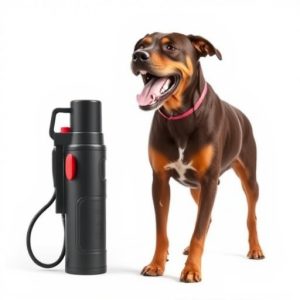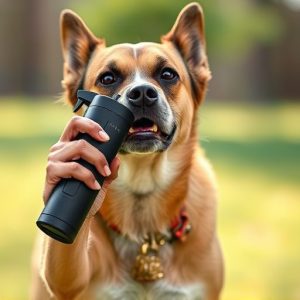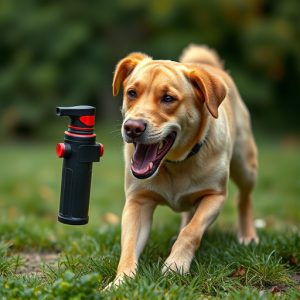Self-Defense Spray for Runners: Navigating Legalities, Safety, and Alternatives
Self-defense spray laws for pets vary by region, creating a complex landscape where runners must bal…….
Self-defense spray laws for pets vary by region, creating a complex landscape where runners must balance public safety and animal welfare. While some areas allow pepper spray for personal protection, using it on dogs is legally uncharted territory with effectiveness questions. Runners should prioritize understanding local regulations, explore non-invasive deterrents like noise makers or whistles, and treat self-defense spray as a last resort, following responsible usage practices and secure storage to avoid pet or human harm.
Runners often turn to self-defense spray as a means of protection against potential dog attacks while on their daily jog. However, navigating the legalities and limitations of this personal defense tool is crucial, especially considering the complex relationship between pets and public safety. This article explores self-defense spray regulations related to pets, delves into the role of governance, presents effective alternatives, and offers tips for runners to ensure safe and responsible usage.
- Understanding Self-Defense Spray: Legalities and Limitations
- Pets and Public Safety: A Complex Relationship
- The Role of Regulations in Dog Deterrent Spray Use
- Effective Alternatives to Chemical Sprays for Runners
- Ensuring Safe and Responsible Usage: Tips for Runners
Understanding Self-Defense Spray: Legalities and Limitations
Self-defense spray, also known as pepper spray or oleoresin capsicum (OC) spray, is a popular tool for personal protection. However, when it comes to using this spray on runners and their dogs, there are crucial considerations regarding legalities and limitations.
In many regions, self-defense spray use is regulated by strict laws that vary based on location. While some areas allow citizens to carry pepper spray for personal safety, there are often restrictions on where and how it can be used. Using spray on an animal, especially a dog, may fall into a legal grey area. It’s essential to understand the Self Defense Spray Regulations in your jurisdiction, keeping in mind that using such spray on pets could have legal repercussions and may not always be considered a valid form of protection. Additionally, the effectiveness of spray against dogs is debatable; its impact can vary based on factors like distance, wind, and the dog’s size and temperament. Therefore, it’s crucial to explore alternative deterrents and safety measures tailored for runners interacting with pets.
Pets and Public Safety: A Complex Relationship
Pets and public safety often find themselves at odds, especially in urban settings where dog populations can be high. While pets bring immense joy and companionship, they also present unique challenges, particularly when it comes to ensuring the security of runners and other outdoor enthusiasts. Self-defense spray for dogs has emerged as a controversial yet potentially life-saving solution.
The use of such sprays is subject to various regulations, with many areas implementing strict rules to balance animal welfare and public safety. This complex relationship requires careful consideration. On one hand, responsible pet owners want to protect their animals from perceived threats; on the other, runners and outdoor athletes require safe spaces to engage in their activities without fear or distraction. Finding a harmonious solution that respects all parties involved is essential, especially as urban planning and pet ownership continue to shape our modern landscapes.
The Role of Regulations in Dog Deterrent Spray Use
The use of dog deterrent spray, also known as self-defense spray, is subject to various regulations across different jurisdictions. These laws are in place to ensure the safe and responsible handling of such products, especially considering their potential impact on both humans and pets. In many regions, self-defense spray must meet specific safety standards and labeling requirements to guarantee its effectiveness while minimizing risks. Users need to be aware of these regulations to comply with local laws and protect themselves legally.
When it comes to pets, regulations often aim to prevent the mistreatment or accidental exposure of animals to dog deterrent spray. Certain areas have restrictions on who can purchase and carry such sprays, as well as where and how they can be used. These measures ensure that individuals using self-defense spray are responsible and that pets are not unintentionally targeted or harmed. Understanding and adhering to these regulations are crucial for runners seeking protection while out on their trails, ensuring a safe environment for both humans and their four-legged companions.
Effective Alternatives to Chemical Sprays for Runners
Many runners prefer a more natural or non-invasive approach to deterring dogs while maintaining their safety. Chemical sprays, though effective, have led to debates regarding their use and potential side effects on both humans and pets under Self Defense Spray Regulations. Fortunately, there are several effective alternatives for runners seeking dog deterrent methods.
One popular option is using a high-decibel noise maker or whistle designed specifically for dog deterrence. The sudden loud sound can startle dogs and encourage them to flee without resorting to chemicals. Additionally, carrying an air horn or a device that emits ultrasonic sounds can be a powerful yet non-harmful tool. Some runners also find success with visual deterrents like bright reflective clothing or waving their arms vigorously to appear larger and more intimidating to dogs. These methods not only protect runners but also ensure the well-being of pets, as they avoid any potential harm associated with chemical sprays.
Ensuring Safe and Responsible Usage: Tips for Runners
Using a dog deterrent spray can be a valuable tool for runners looking to protect themselves while on their routes, but it’s crucial to employ it safely and responsibly. First and foremost, familiarize yourself with local Self Defense Spray Regulations, as laws vary widely. Ensure you understand the range, usage instructions, and any restrictions related to pets and other animals. Always carry the spray in a readily accessible location, but avoid drawing attention to it, as this could deter potential helpers if needed.
Before using the spray, consider alternatives like noise makers or training your dog to stay clear of runners. If confrontation is unavoidable, aim for the eyes and face—areas sensitive to spray irritants—while keeping in mind that responsible usage should only occur as a last resort to protect yourself. Regularly inspect and maintain your spray device, ensuring it’s in proper working order, and store it securely to prevent unauthorized use or accidental deployment.
While self-defense spray can offer a layer of protection against potential dog attacks, it’s crucial to understand the legalities, limitations, and responsible usage guidelines surrounding its use. With varying regulations on self-defense spray for pets, runners must stay informed about local laws to ensure safe and legal protection. By exploring effective alternatives and prioritizing public safety, individuals can make informed decisions regarding their well-being while running, coexisting harmoniously with our four-legged neighbors.


